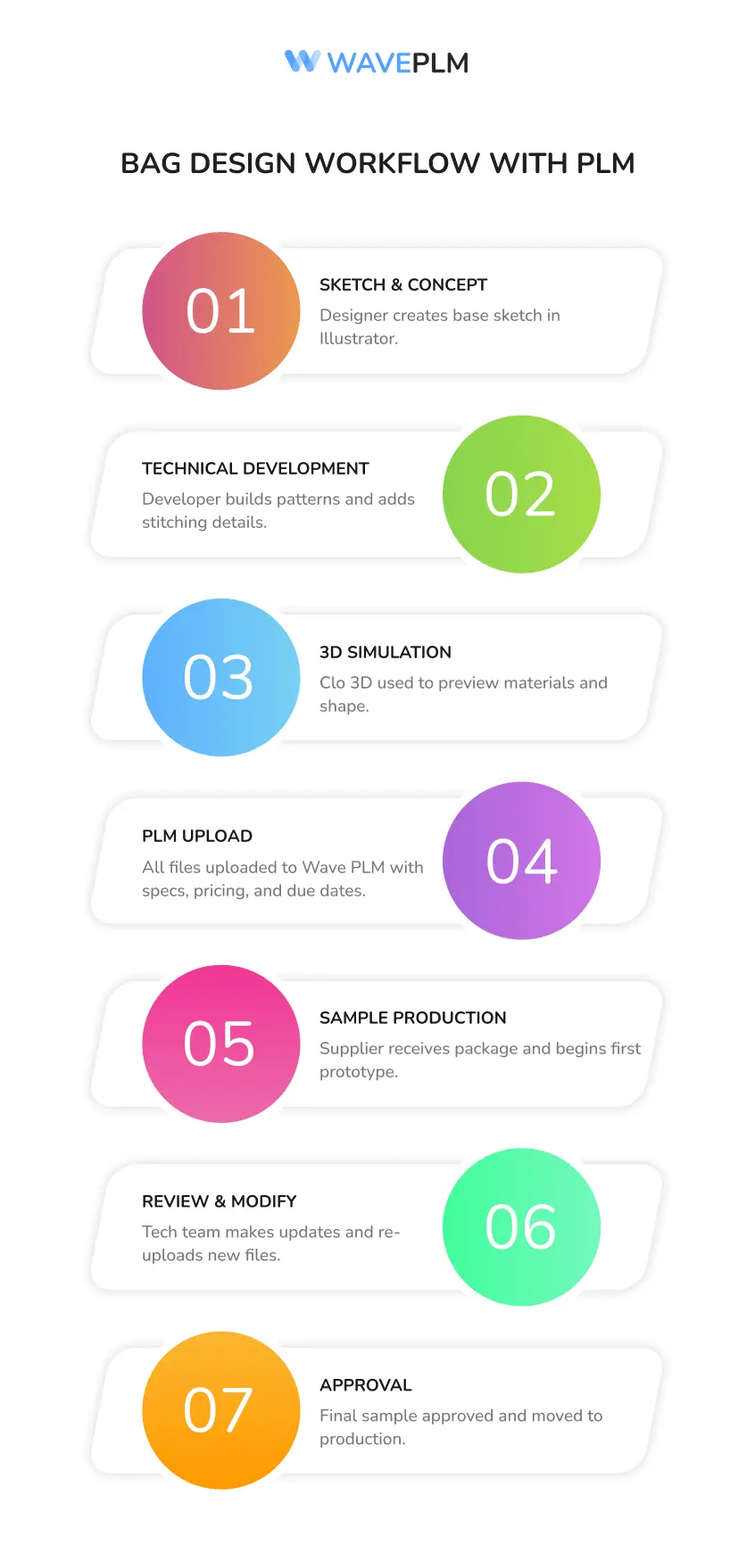
Designing bags is both a creative journey and a complex technical process. While imagination and artistic direction bring the initial spark, it’s structure, workflow, and precise communication that shape a sketch into a finished product. That’s why selecting the best software for bag design is no longer optional—it’s a competitive advantage. These tools allow designers and brands to create bag designs that are both visually compelling and technically accurate.
In today’s fashion landscape, consumers expect innovation, sustainability, and speed. Digital tools are now essential for managing every step—from creative ideation to sample approval and supplier collaboration. With the right software, brands can streamline workflows, minimize errors, and bring high-quality bags to market faster than ever before.
This guide explores how to:
- Use software to simplify and strengthen your bag design process
- Identify essential features in handbag development tools
- Enable better teamwork with PLM for accessories
- Compare leading solutions for different stages and bag types
- Create bag designs that reflect brand values and customer needs
- Answer key industry questions about tools, machines, and profits
Let’s explore how digital solutions are transforming the future of bag design.
Why Bag Design Software is a Game Changer
The market for bags—ranging from fashion handbags to utility backpacks—is fast-moving and consumer-driven. As expectations grow, traditional design methods no longer offer the speed or precision needed to stay competitive.
Bag design software gives designers, developers, and manufacturers a shared, digital space to:
- Create 2D sketches and advanced 3D visualizations
- Generate technical sketches and bag patterns directly from concepts
- Simulate how materials look and behave in real life
- Upload product specifications and tech packs for production
- Reduce waste through more accurate first samples
- Improve communication between teams, factories, and stakeholders
By using these tools, brands can focus on creativity while ensuring their designs are production-ready. A good solution eliminates guesswork and replaces it with clear, measurable design intent.

Core Features to Look For in Bag Design Software
Not all fashion design software is made for accessories. Designing bags involves distinct challenges—structural complexity, material layering, and hardware fitting. Here are key features you should prioritize:
|
Feature |
What It Enables |
|---|---|
|
2D & 3D Design Capabilities |
Allows for sketching, shaping, and simulating bag forms in real-life scale |
|
Customizable Templates |
Save time by modifying base styles for totes, satchels, backpacks, and more |
|
Fabric, Material & Color Libraries |
Enable consistent use of finishes, colors, and accessories across collections |
|
Technical Specification Tools |
Add all details: seams, hardware, components, and precise measurements |
|
Seamless PLM Integration |
Ensure real-time syncing between creative, technical, and sourcing teams |
|
Easy Upload & Export Options |
Click-to-export patterns, sketches, and tech packs for quick handoff |
The best design software for handbags helps teams collaborate across regions, disciplines, and time zones. It ensures that what’s drawn gets made right the first time.
Why PLM for Accessories Matters
PLM (Product Lifecycle Management) software offers more than just data storage. For accessory brands, it functions as a digital command center.
Top Benefits of PLM for Bag Design:
- Centralized Workspace: Keep all bag designs, samples, price sheets, and production timelines in one location.
- Team Collaboration: Everyone—designers, developers, buyers, and factory managers—stays on the same page.
- Reduced Sampling Waste: High-quality tech packs and accurate specs lower the number of prototypes needed.
- Faster Time to Market: Automated workflows help speed up review and approval cycles.
- Seamless Communication: Clarify design intent for manufacturers with annotated sketches, specs, and materials.
When bag design software is integrated with PLM, accessory product development becomes more agile and scalable.

Leading Software Options for Bag Design
Every stage of bag development requires different tools. Some are best for sketching; others for 3D rendering or manufacturing specs. Below is a comparison of top tools:
|
Software |
Best For |
Key Features |
|
Adobe Illustrator + Plugins |
Initial Sketches & Tech Packs |
Familiar interface, plugin support, easy for creating mockups |
|
Clo 3D |
Realistic 3D Bag Simulation |
Motion, texture, stitching simulation in real time |
|
CorelDRAW |
Precision Vector & Pattern Drafting |
Ideal for accurate panel cutting, color blocking, and layouts |
|
Rhino |
Structural Modeling for Bags |
Advanced modeling of 3D surfaces and details like buckles, frames |
|
Full Accessory Workflow Management |
Combines PLM, sketches, upload tools, and technical documentation |
Each tool contributes to the overall design process. Many brands use two or three in tandem to complete their collections.
Mastering Technical Bag Design
Technical bag design means turning an idea into blueprints. It includes:
- Creating technical sketches with side, top, and inside views
- Adding annotations for seam types, piping, and closures
- Uploading spec sheets with real-life measurements
- Modifying existing patterns for material or size changes
- Reviewing design intent with the factory before sampling
The accuracy of your technical sketches determines how close the sample will be to your original vision.
Creating Bag Designs with Brand Identity
No matter your market—luxury, sports, streetwear—bag designs should reflect your brand personality and values.
Design software helps you:
- Start from scratch or import sketches to build new styles
- Choose materials and colors that support seasonal concepts
- Customize bag types for gender, activity, or trend category
- Modify older patterns to build capsule collections
- Maintain consistency in stitching, hardware, and finishes
Tools also enable a unified look across collections, increasing customer recognition and loyalty.
Real-Life Bag Design Workflow Example
Here’s how a modern accessory company might use software and PLM:
- Sketch & Concept: Designer creates base sketch in Illustrator.
- Technical Development: Developer builds patterns and adds stitching details.
- 3D Simulation: Clo 3D used to preview materials and shape.
- PLM Upload: All files uploaded to Wave PLM with specs, pricing, and due dates.
- Sample Production: Supplier receives package and begins first prototype.
- Review & Modify: Tech team makes updates and re-uploads new files.
- Approval: Final sample approved and moved to production.
This workflow streamlines everything—from creation to commercialization.

Questions Designers Often Ask
What is the best free software for fashion or bag design?
Blender (for 3D modeling) and Inkscape (for vector art) are free, open-source options. They require more learning but offer flexibility.
What machines are needed to make bags?
You’ll need: industrial sewing machines, pattern plotters, cutting tables, riveting machines, and hardware attachments depending on bag type.
Is it profitable to make bags?
Yes—especially if you carve out a niche. Profit depends on sourcing cost, brand price point, and how efficiently you manage the design-to-production process.
The Ultimate Bag Design Software Checklist
Here’s a quick checklist to evaluate your current bag design software and decide whether it’s time to upgrade:
✅ Allows sketching and pattern creation for various bag types
✅ Supports 3D simulation of bags with realistic materials and motion
✅ User friendly interface for both creative and technical teams
✅ Enables uploading and real-time syncing with PLM platforms
✅ Stores and reuses design templates, material libraries, and color palettes
✅ Optimized specifically for accessories—not just general fashion items
✅ Exports complete tech packs and specification sheets with one click
If your current solution doesn’t meet at least 5 of these requirements, consider switching to a more robust system to streamline your accessory product development process.
Final Thoughts: Bringing Bag Designs to Life
The art of designing bags is evolving. Today, success means being able to start with a sketch, develop it digitally, test it virtually, and manufacture it reliably. From concept to store shelf, every step matters—and every tool you use should serve your brand’s creative and commercial goals.
With a combination of powerful tools and smart workflows, you can:
- Create beautiful, functional bags that customers love
- Streamline the process from idea to factory
- Enable your teams to collaborate globally
- Bring new collections to market faster and with fewer errors
Ready to Start?
Wave PLM offers a powerful and user-friendly platform tailored to fashion and accessory brands. You can:
- Upload bag sketches, patterns, and files in one place
- Manage collections, suppliers, and approvals
- Automate workflows and reduce back-and-forth
Whether you’re a startup or a large company, Wave PLM helps you design with speed, confidence, and quality.
👉 Book a demo today and see how we can support your accessory product development.





Leave a Reply